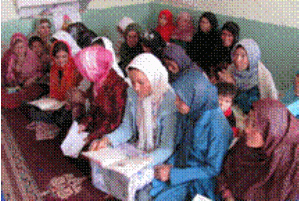
In Kabul, women and girls of all ages are learning to read and write thanks to the initiative and dedication of Fazila.
USAID/Creative Associates
Education and literacy are the keys to improving the lives of women throughout Afghanistan
22 JANUARY 2011 | KABUL, AFGHANISTAN
Women queue in a long winding line at a health center in a remote part of Kabul Province every day. Many have their children with them. Few women in the community can read the alphabet and are completely dependent on others to read for them. Few women hold jobs outside of the home. Through word of mouth, women hear about a free literacy center nearby.
Fazila converted two rooms in her house into classrooms. A teacher by profession, she developed the idea to provide basic hygiene awareness and literacy education to 50 women and girls in her community and obtained a quick impact grant from the USAID-supported Ambassador’s Small Grants Program.
“The majority of people in this area are internally displaced from other provinces. They are poor and cannot afford to send their children to schools,” Fazila says. School age girls in the community cannot afford the books or clothes needed to attend school. Instead, they weave carpets in their houses to support their families. “[If she were at school] my daughter would be missing for half a day which can cause delay in finishing weaving her carpets,” said a mother who studies in the same class with her daughter. Now, her daughter attends classes for several hours a day and still works to support her family. “I can read signs and billboards when I’m in town and when my husband gives me 100 Afghanis, I am now able to keep track of the money I spend on different things,” says another woman.
Groups of women and girls, ranging in age from six to 70, attend classes for several hours each day. “I was blind before. Now with an education, I can see,” says an elderly woman after reciting the alphabet in front of the class.







Comment
Make a general inquiry or suggest an improvement.